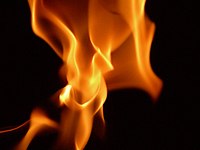
Photo from wikipedia
Abstract A theoretical analysis is described to study the effect of centrifugal acceleration, especially high centrifugal acceleration, i.e. more than 200 times of gravity acceleration (200g), on the premixed flame… Click to show full abstract
Abstract A theoretical analysis is described to study the effect of centrifugal acceleration, especially high centrifugal acceleration, i.e. more than 200 times of gravity acceleration (200g), on the premixed flame speed in a rotating closed tube. Based on one-dimensional (1-D) steady adiabatic flame model, simplified governing equations are directly solved by integration method in the reaction zone. A theoretical prediction that describes the premixed flame speed in a rotating closed tube is obtained. The theoretical prediction agrees well with the experimental data obtained by Lewis & Smith. The result verifies that the flame speed accelerated by the centrifugal force is nearly proportional to the square root of the centrifugal acceleration. It is shown by theoretical analysis that the flame speed in a rotating closed tube is determined by the initial temperature, the critical ignition temperature, the adiabatic flame temperature and the thicknesses of reaction zone. The premixed flame speed in a rotating closed tube increases nearly linearly with the increasing of the initial temperature or square root of the thicknesses of reaction zone, or with decreasing of the critical ignition temperature or the adiabatic flame temperature.
Journal Title: International Journal of Hydrogen Energy
Year Published: 2017
Link to full text (if available)
Share on Social Media: Sign Up to like & get
recommendations!